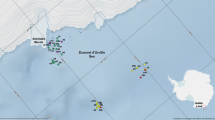Abstract
The thalli ofHalimeda tuna (Ellis & Solander) grow horizontally from rocky surfaces and present an upper and lower surface which can be colonized by epiphytes. Thalli ofH. tuna were collected twice a month from March 1985 to March 1986 at Tossa de Mar (northeast Spain). Thirty five species of hydroid were recorded living onH. tuna thalli; of these, the 15 most abundant species were classified into three groups on the basis of their horizontal zonation on the thalli: those most abundant on the proximal, medial or distal articles. Those hydroids common on the proximal (oldest) articles were relatively large and were present throughout the year, those common on the medial articles were smaller and often occurred in dense monospecific patches, while those common on the distal (youngest) articles were present for only short periods and were the most opportunistic hydroids found onH. tuna. We hypothesize that this zonation reflects interspecific niche-selection, enabling successful competition for space with other hydroids, algae and bryozonas. Three hydroid species were more abundant on the upper surfaces of the algae than on the lower, probably because of gravitationally enhanced settlement of planula larvae coupled with (unusually) limited hydrorhizal growth on the underside. Three opportunistic species were more common on the lower surfaces of the thalli, possibly reflecting the greater availability of substratum in the shade, where epiphytic algae were less abundant. Many hydroids declined in abundance in summer because of the death of old thalli, the growth of new thalli and of apical articles on existing thalli, and possibly because of interspecific competition with epiphytic algae. The death of old thalli and the growth of new thalli reduced the abundance of epiphytic algae; this may have facilitated the increase in abundance of hydroids recorded in the autumn.
Similar content being viewed by others
Literature cited
Ballesteros, E. (1984). Els vegetals i la zonacio littoral: especies, comunitats i factors que influeixen en seva distribucio. PhD thesis, University of Barcolona
Barange, M., Gili, J. M. (1988). Feeding cycles and prey capture in the hydroidEudendrium racemosum. J. exp. mar. Biol. Exol. 115: 281–293
Boero, F. (1984). The ecology of marine hydroids and effects of environmental factors: a review. Pubbl. Staz. zool. Napoli (I: Mar. Ecol.) 5: 93–118
Boero, F., Fresi, E. (1986). Zonation and evolution of a rocky bottom hydroid community. Pubbl. Staz. zool. Napoli (I: Mar. Ecol.) 7: 123–150
Garcia-Rubies, A. (1987). Distribution of epiphytic hydroids onPosidonia sea grass. In: Bouillon, J., Boero, F., Cicogna, F., Cornelius, P. F. S. (eds.) Modern trends in the systematics, ecology, and evolution of hydroids and hydromedusae. Oxford Science Publications, Oxford, p. 143–155
Gili, J. M. (1986). Estudio sistematico y faunistico de los cnidarios de la costa Catalana. PhD thesis. University Autonoma de Barcelona
Gili, J. M., Murillo, J. Ros, J. D. (1989). The distribution pattern of benthic cnidarians in the Western Mediterranean. Scientia mar. 53: 19–35
Hayward, P. J. (1980). Invertebrate epiphytes of coastal marine algae. In: Price, J. H., Irvine, D. E. R., Farnham, W. F. (eds.) The shore environment. Vol. 2. Ecosystems. Academic Press, London, p. 761–787
Hughes, R. G. (1975). The distribution of epizoites on the hydroidNemertesia antennina (L.). J. mar. biol. Ass. U.K. 55: 275–294
Hughes, R. G. (1987). The loss of hydranths ofLaomedea flexuosa Alder and other hydroids, with reference to hydroid senescence. In: Bouillon, J., Boero, F., Cicogna, F., Cornelius, P. F. S: (eds.) Modern trends in the sytematics, ecology, and evolution of hydroids and hydromedusae. Oxford Science Publications, Oxford, p. 171–184
Hughes, R. G., Johnson, S., Smith, I. D. (1991). The growth strategies of some hydroids that are obligate epiphytes of seagrass leaves. Hydrobiologia (in press)
Huve, P. (1954).Hydranthea etCampalecium genres Mediterranéens aberrants d'hydroides de la famille des haleciides. Recl Trav. Sth mar. Endoume 13: 173–192
Kato, M., Hirai, E., Kakinuma, Y. (1967). Experiments on the coaction among hydrozoan species in the colony formation. Sci. Rep. Tôhoku Univ. (Ser. 4: Biology) 29: 317–325
Meinesz, A. (1980) Contribution à l'étude des Caulperpales (chlorophytes). Ph.D. thesis. Université Nice
Riedl, R. (1959). Die Hydroiden des Golfes von Neapel und ihr Anteil an der Fauna unterirdischer Höhlen. Ergebnisse der Österreichischen Tyrrenia-Expedition 1952. Teil XVI. Pubbl. Staz. zool. Napoli 30 (Suppl.): 591–755
Riedl, R. (1966). Biologie der Meereshöhlen. Paul Parey, Hamburg
Seed, R. (1985). Ecological patterns in the epifaunal communities of coastal macroalgae. In: Moore, P. G., Seed, R. (eds.) The ecology of rocky coasts. Hodder & Stoughton, London, p. 22–35
Sieburth, J. M., Conover, J. T. (1964).Sargassum tannin, an antibiotic which retards fouling. Nature, Lond. 208: 52–53
Standing, J. (1976). Fouling community structure: effects of the hydroid,Obelia dichotoma, on larval recruitment. In: Mackie, G. O. (ed.) Coelenterate ecology and behavior. Plenum Press, New York, p. 155–164
Stebbing, A. R. D. (1973). Competition for space between epiphytes ofFucus serratus L. J. mar. biol. Ass. U.K. 53: 247–261
Stechow, E. (1919). Zur Kenntnis der Hydroidenfauna des Mittelmeeres, Amerikas und anderer Gebiete. Zool. Jb. (Abt.) Syst. Ökol. Geogr. Tiere) 42: 1–172
Author information
Authors and Affiliations
Additional information
Communicated by J.M. Pérès, Marseille
Rights and permissions
About this article
Cite this article
Llobet, I., Gili, J.M. & Hughes, R.G. Horizontal, vertical and seasonal distributions of epiphytic hydrozoa on the algaHalimeda tuna in the Northwestern Mediterranean Sea. Mar. Biol. 110, 151–159 (1991). https://doi.org/10.1007/BF01313102
Accepted:
Issue Date:
DOI: https://doi.org/10.1007/BF01313102




